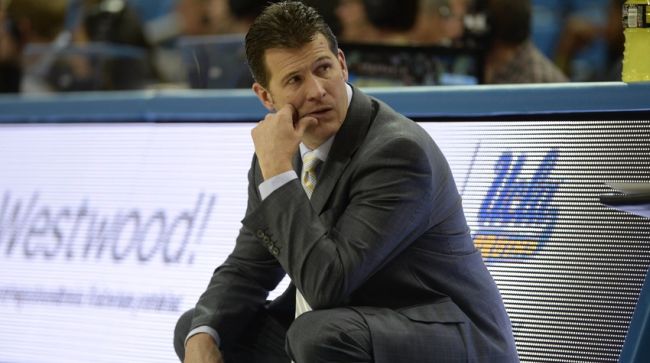The Achilles’ Heels of Arizona, Oregon and UCLA
Posted by Richard Abeytia on February 18th, 2017The Pac-12’s Big Three of Arizona, Oregon and UCLA (in no particular order) have spent most of the regular season displaying their numerous virtues, but for these three programs their ultimate referendum is going to be performance in the NCAA Tournament. The trio certainly won’t be the only Pac-12 schools to qualify for the Big Dance this season, but they will be expected to carry the banner for the Conference of Champions deep into March (last men’s basketball championship: Arizona, 1997). So what to make of the Wildcats, Ducks and Bruins as we approach three weeks until Selection Sunday? Their talent is unquestioned, but each team carries at least one potentially tragic flaw that must be reconciled if it has plans on booking a trip to the Final Four.
Arizona: Inexperience

Lauri Markkanen is a potentially game-changing talent, but will his inexperience catch up to him in the Big Dance? (Getty)
No team epitomizes the conference’s youthful resurgence like Arizona. In Pac-12 play, freshmen Lauri Markkanen, Rawle Alkins and Kobi Simmons represent nearly half of Arizona’s field goal attempts and scoring. That hasn’t mattered until recently, but a reckoning more commonly known as “The Freshman Wall” is imminent. Rare is the first-year collegian who can completely sidestep a prolonged dip in performance. Markannen recently went through a two-week stretch of poor performances, punctuated by four-point, three-rebound stinker at Oregon. Simmons has also struggled with inconsistency in league play. His masterpiece against UCLA was the precursor to an ineffective 2-of-7 game against Utah. Another inconsistent swing through Oregon cost Simmons his starting job, and his 19 minutes against Stanford represented a season low. He bounced back somewhat against California with 13 points and three assists, but he doesn’t seem quite as comfortable as he once did. Alkins also struggled against the Oregon schools, but he played well in recent games against Stanford and Washington State. Teams have certainly won NCAA titles led by talented youth, but it’s also not hard to imagine a team like Arizona cracking against a veteran-laden athletic group like Villanova. Arizona has plenty of time to find greater consistency among its freshman corps, but like the rest of us, Sean Miller is probably still wondering what are his young Wildcats made of?
UCLA: Defense
No need to bang the drum about UCLA’s defense any more than it already has been. The Bruins’ modus operandi seems pretty well codified into characterization at this point, but they are still very much a threat because Steve Alford has transcendent talent and the best offense in the game. Again, UCLA only have to be competent defensively to make a deep run, much like it was for the second half of its big win over Oregon. How good does the defense need to be? Let’s look at the last five National Champions: Per KenPom, Villanova, Duke, Connecticut, Louisville and Kentucky each ranked 12th or higher in defensive efficiency. The Bruins are currently ranked 122nd. If UCLA wants to take advantage of the most west-friendly geographic NCAA Tournament set-up (Sacramento/San Jose/Glendale) arguably since it last won the title in Seattle in 1995, the Bruins need to start guarding on a more consistent basis.
Oregon: Post Play
Watching Oregon against UCLA last week really drove home both the best and the worst of the Ducks. Dana Altman has seemingly committed to a starting lineup of Dylan Ennis, Jordan Bell, Tyler Dorsey, Dillon Brooks and Payton Pritchard. That’s a versatile, skilled and athletic lineup that few teams in college basketball can handle. But it’s also a small lineup, and UCLA demonstrated the downside of playing such a quintet when it torched the Ducks in the paint. Altman lamented UCLA’s constant pressure on the offensive boards leading to the second chance points that he felt cost the Ducks the game. This area of the game, however, isn’t where Oregon’s stark lack of size hurts the most. Rather, when the Ducks’ jumpers came up dry and UCLA correspondingly cut off their driving lanes, Altman’s offense completely stalled out. What they could have used was a post presence to stabilize things and get some inside-out offense going. Chris Boucher looks nice on paper, but he basically plays like a wing trapped in a 6’10” big man’s body. Most of his time is spent in the corners behind the three-point line. He is an active interior defender and a good rebounder but he’s just not a strong post presence. The Ducks don’t have anybody like the UCLA bigs in the post. You have to figure that will eventually catch up to Oregon in the NCAA Tournament.
None of these flaws are necessarily fatal on their own, but for three teams with their eyes on a trip to Glendale in April, they are certainly conspicuous. Odds are good that when a team eliminates these three, it will be because they were able to exploit their notable Achilles’ heels. And if any of this group actually arrives intact in the Valley of the Sun, it will likely be because they overcame those glaring issues.










































